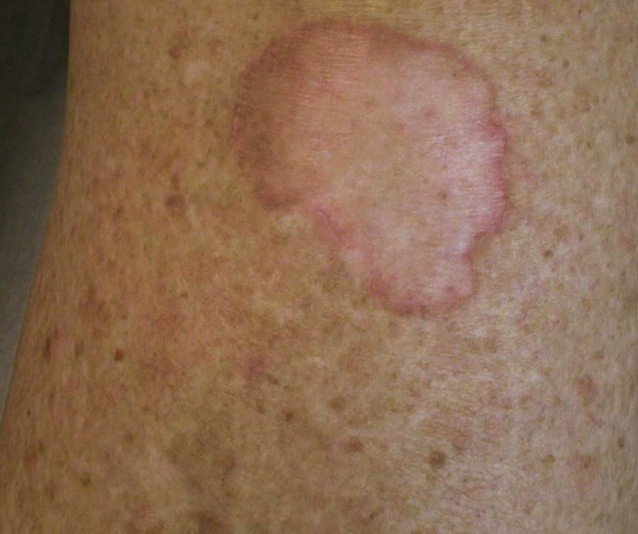Porokeratosis
What is Porokeratosis?
Porokeratosis is a medical condition in which the process of keratinization is affected and disrupted. The patient presents patches of atrophy on the skin, these having distinctive clinical and histopathological features. The most distinctive feature is the border surrounding the patch, this being obviously hyperkeratotic. This border is also known as the cornoid lamella. Porokeratosis has more than just one clinical variant and you will find them presented below. Also, keep in mind that squamous cell carcinoma can develop within porokeratosis patches.
These are the most common forms of porokeratosis:
- Classic porokeratosis of Mibelli
- Disseminated superficial actinic porokeratosis (there is also a non-actinic variant identified)
- Linear porokeratosis
- Disseminated plantar and palmar porokeratosis
- Punctate porokeratosis
Less common forms include:
- Porokeratosis ptychotropica (verrucous variant, localized on the buttocks)
- Porokeratoma (also known as porokeratotic acanthoma)
- Porokeratotic adnexal ostial nevus (rare congenital disorder)
- Pruritic papular porokeratosis
Porokeratosis Symptoms
The symptoms of porokeratosis depends on the actual form of the skin condition:
Classic porokeratosis of Mibelli
- Small lesion located on extremities (more common) or in the genital area or mucous membrane (less common).
- These lesions do not cause other symptoms in the majority of cases.
- In some patients, mild itchiness may occur.
- Lesions expand gradually but slowly over the course of years.
- In immunosuppressed adults, lesions can appear and go through a rapid growth period.
- Diameter of several cm (medical literature depicts cases of giant lesions, up to 20 cm in diameter).
- Center of the lesion can suffer from modification of pigmentation (hyper or hypo).
- In some cases, the center of the lesion presents scales. It can also be atrophic or characterized by the absence of hair.
- Hyperkeratotic patches might also be present on the skin.
Disseminated superficial actinic porokeratosis
- Multiple macules present on the arms and legs (distal extensor surface)
- Presence of cornoid lamella
- No lesions on the palms and soles
- In some patients, facial lesions may occur
- Hyperkeratotic patches might also be present in some cases
- Lesions usually asymptomatic
- Itchiness or burning sensation may accompany the lesions in certain cases
- The non-actinic variant presents a generalized distribution of the lesions
Linear porokeratosis
- Red or brown patches on the skin (unilateral)
- Keratotic papules or plaques (linear distribution)
- The distribution is along the embryonic lines of Blaschko
- Less common – bilateral or generalized distribution
- High risk of malignancy degeneration
Disseminated plantar and palmar porokeratosis
- Areas affected – palms and soles
- Generalized distribution or along the embryonic lines of Blaschko
- Usually asymptomatic
- May present itchiness or tenderness to palpation
- Discomfort when walking in plantar lesions
Punctate porokeratosis
- Multiple keratotic papules
- Presence of cornoid lamella
- Areas affected – palms and soles.
Causes of Porokeratosis
These are the most common causes and risk factors that lead to porokeratosis:
- Genetic inheritance
- Exposure to artificial ultraviolet light and prolonged exposure to the sun
- Deficiency of the immune system
- Renal transplants
- Radiation therapy
- Chemical and thermal burns
- Dialysis
- Photodynamic therapy
- Cancer
Treatment
As there are so many different types of porokeratosis and they can all manifest differently in various patients, it should come as no surprise that the treatment of this condition is highly particularized. When prescribing a certain treatment, the doctor will take into consideration how spread the lesions are on the skin, where they are located and what are the risks of them becoming cancerous. However, apart from treatment, the patient will be recommended to avoid sun exposure, to use high SPF sunscreen when going out and to come to regular check ups so as any signs of cancer can be immediately identified.
These are the most common courses of treatment for porokeratosis:
- Topical 5-fluorouracil – improves the symptoms and induces remission of all forms of porokeratosis.
- Analogues of D3 vitamin – these are administered as topical treatments as well, being especially recommended for the disseminated superficial actinic porokeratosis. Two of the most recommended choices are calcipotriol and tacalcitol.
- Anti-inflammatory creams, such as diclofenac, might also be used for the disseminated superficial actinic porokeratosis.
- Modulators of the immune system – these are administered as topical treatments and the most recommended choice is imiquimod cream. This treatment is especially recommended for the classic form of porokeratosis (Mibelli).
- Retinoids
- Topical retinoids are recommended in the cases of porokeratosis where the cornoid lamella is present. They can reduce the level of excessive keratosis and reduce this distinctive border of the lesion. However, these are not recommended to be taken for prolonged periods of time, as they can have serious side-effects on one’s health.
- Oral retinoids are recommended only in severe cases of porokeratosis, where there is an increased risk for malignancy degeneration.
Porokeratosis Pictures
Here are some of the pictures collection of the condition Porokeratosis…



